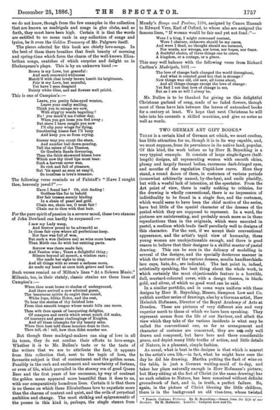TWO GERMAN ART GIFT BOOKS.*
THERE is a certain kind of German art which, we must confess, has little attraction for us, though it is in its way capable, and, we must suppose, from its prevalence in its native land, popular. Of this kind, the work before us by Herr R. Beyschlag is a very typical example. It consists of large single-figure (half- length) designs, all representing women with smooth skins, plump and largely framed bodies, enormous dark-fringed eyes, and months of the regulation Cupid-bow curve. Here they stand, a round dozen of them, in costumes of various periods (somewhat arbitrarily named, by-the-bye), and smile placidly, but with a woeful lack of intention, at the spectator. From the Art point of view, there is really nothing to criticise, for the drawing is wholly conventional, there is no impression of individuality to be found in a single face, and the costumes, which would seem to have been the chief motive of the series, have but little of the special character of the dresses of the period which they are supposed to represent. In a word, the pictures are uninteresting, and probably much more so in these reproductions than in the originals, which were executed in pastel, a medium which lends itself peculiarly well to designs of this character. For the rest, if we accept their conventional appearance, and the artist's tepid view of humanity, these young women are unobjectionable enough, and there is good reason to believe that their designer is a skilful master of pastel drawing. This can be seen in the delicacy of modelling in several of the designs, and the specially dexterous manner in which the textures of the various dresses, muslin handkerchiefs, lace caps, hats, &c., are indicated. The last point is, indeed, artistically speaking, the best thing about the whole work, in which certainly the most objectionable feature is a horrible, dull, mustard-coloured cover, with a design thereon, in black, gold, and silver, of which no good word can be said.
In a similar portfolio, and in some ways uniform with these designs by Herr R. Beyschlag, Messrs. Sampson Low and Co. publish another series of drawings, also by a German artist, Herr Heinrich Hofmann, Director of the Royal Academy of Arts at Dresden. These are pictures of very different aim and very superior merit to those of which we have been speaking. They represent scenes from the life of our Saviour, and albeit the view which they take of the various incidents is what may be called the conventional one, as far as arrangement and character of costume are concerned, they are nall, only well drawn and composed, but have here and there considerable grace, and depict many little truths of action, and little details of Nature, in a pleasant, simple fashion.
As usual, what is best in the designs is that which is nearest to the artist's own life,—in fact, what he might have seen the day he did his drawing. Martha putting the flask of wine on the table, is just a German waiting-maid of to-day, and takes her place naturally enough in Herr Hofmann's picture; but Mary sitting at the feet of Christ (in the same drawing) has no such relation to Nature, has been conceived without definite groundwork of fact, and is, in truth, a perfect failure. So, again, in the picture of Christ blessing the little children, there is in the background an old vine-tree, whose twisted
• Female Costume Pictures. By H. Beysohlaw.—Scenes from the Life of our Saviour. By H. Hofmann. London : Sampson Low and Co.
trunk and serrated leaves give, by their fidelity, an im- pression of reality to the scene such as it would otherwise wholly lack. And in the same picture, it may be noticed that the one or two natural—or rather, perhaps, naturally likely— gestures of the children count for far more in the pleasure given to the spectator, than the elaborate and slightly forced composition.
The vital deficiency in Herr Hofmann's illustrations, is that the proportion of Nature which he chooses to admit is, taking the series as a whole, but small. He has learnt to draw well ; he has studied Art from the sides of tradition and composition, and the result is that this artist does but in the main repeat his lesson more or less accurately. His pictorial lecture has been written out for him, and his attempt is to deliver it accu- rately, with just emphasis and discretion. The shadow, in fact, of the schoolmaster is here, as in so much German art, —the ease and pleasantness, the freshness of impression, the originality, sometimes extravagant, but always attractive, of a definite human intellect; the passing of all the truths treated of, as it were, through the coloured glass of the artist's eye and mind,— all these have slipped away from most of the modern German artists ; they are strenuous in their efforts, but direct them badly ; they learn, but hardly love their work ; they make pictures, but hardly see them ; they arouse our admiration, but never touch our heart. It might be said of them, artistically, that they have all other gifts than charity (or love) ; and for the lack of this, as in the greater matter, their art is but a "sound- ing brass and tinkling cymbal."



































 Previous page
Previous page